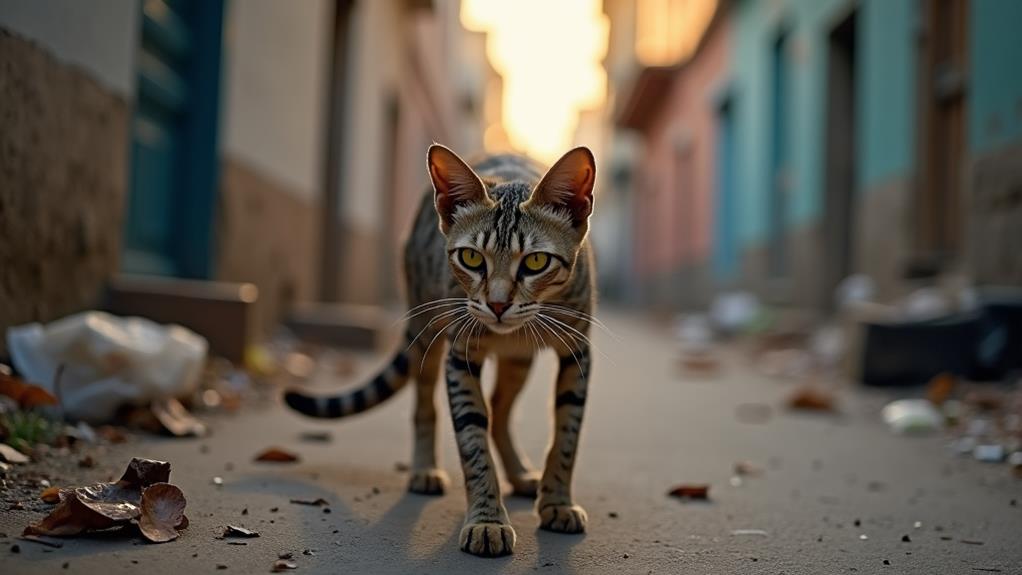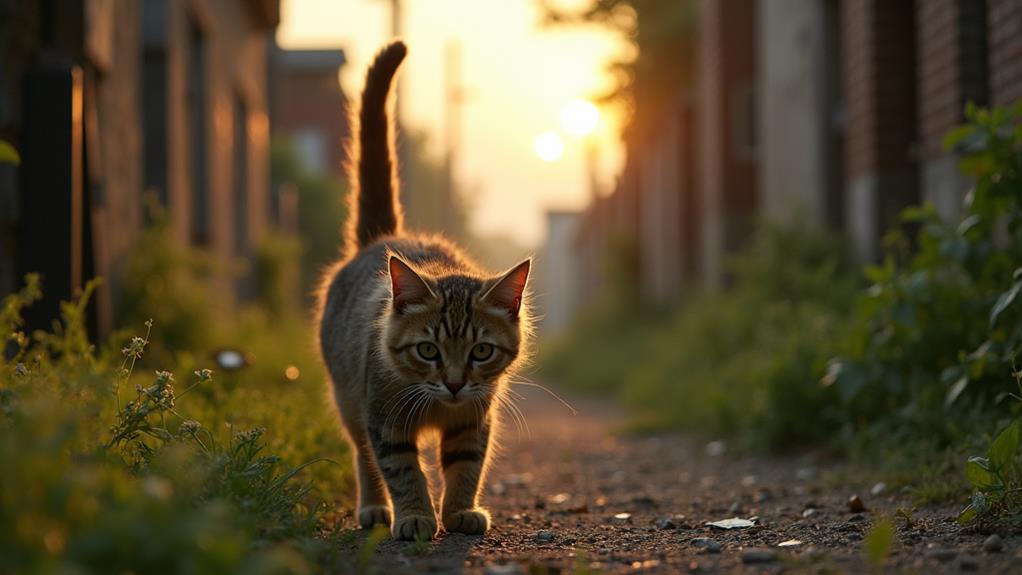How to Attract a Feral Cat: Tips for Humanely Luring Them

To attract a feral cat, start by understanding their behavior. Feral cats are cautious and require quiet, safe spaces to feel secure. Use smelly baits like canned mackerel, sardines, or KFC chicken to draw them in. Improve the lure with non-food items like catnip. Set up humane traps in strategic locations, camouflaging them with natural materials to reduce anxiety. Employ distraction techniques, such as using a laser pointer or sound distractions. Always handle captured cats safely by wearing gloves and keeping them calm. Connect with community support for effective feral cat management. There's more to uncover on creating lasting solutions.
Understanding Feral Cat Behavior
Understanding feral cat behavior is fundamental if you're looking to attract them. Feral cats are unsocialized and often avoid human contact, making strategic efforts vital. They typically form colonies, and their territorial nature means you'll need to identify their preferred areas. Observing their routines can help you pinpoint these territories, which is key to successfully luring them. Since feral cats are wary of unfamiliar environments, it's significant to create a quiet and safe space to make them feel comfortable.
Food sources play a noteworthy role in attracting feral cats. They approach food with caution, so patience is essential. Place food in a consistent spot, allowing them to gradually trust the area over time. Their behavior is influenced by their need to survive in colonies, and understanding this can aid in your efforts to engage with them.
Unlike stray cats, feral cats rarely seek human interaction, so recognizing this difference is fundamental. By focusing on their behavior and adapting your approach, you increase your chances of successfully attracting them. Remember, patience and quiet persistence are your best allies regarding understanding and working with feral cats.
Choosing the Right Bait
Selecting the right bait is crucial for successfully attracting feral cats to your trap. Smelly food is your best bet. Options like canned mackerel, sardines, or even the KFC original chicken recipe work wonders due to their strong scents. You might also consider jarred baby food, as long as it doesn't contain onions. Its unique aroma and texture can lure even the wariest of feral cats toward the trap.
To make your bait even more appealing, combine food options with non-food items like catnip or valerian root. These supplements can improve the overall attraction and encourage cats to investigate further. An effective strategy involves creating a scent trail leading to the trap. Place small amounts of the bait at intervals, gradually guiding the cat toward the trap's entrance.
Setting Up Humane Traps

When setting up humane traps for feral cats, it is vital to choose equipment specifically designed for them, making certain the traps are both spacious and in good working order. These traps should be large enough to comfortably accommodate the wary nature of these felines. Once you've selected the right trap, it is imperative to set it up in quiet, protected areas where cats frequently pass by. Monitoring their paths can help you identify the best places to position the trap for maximum success.
For bait, use appealing food such as canned mackerel, tuna, or jarred baby food (without onions). Place this enticing bait at the back of the trap to encourage the cats to enter fully. This positioning is key to triggering the trap mechanism effectively.
To reduce visibility and anxiety, camouflage the trap with natural materials or dark towels. This step makes the trap less intimidating and more inviting for cautious cats. Once set, check the trap regularly, ideally every 30 minutes. Frequent monitoring minimizes stress on captured cats and guarantees they're promptly taken to veterinary care or released safely. By following these steps, you can humanely and effectively capture feral cats.
Effective Trap Placement
After setting up the right traps, focus on placing them effectively to boost your chances of capturing feral cats. Start by identifying known feeding areas or shelters, as these are where feral cats often seek food and safety. Placing your traps in these spots will greatly improve your capture chances. Moreover, choose quieter locations for trap placement to reduce disturbances and stress for the cats. They prefer secluded areas where they feel protected from potential threats.
To further increase your success rate, monitor the cats' behavior and observe their regular paths. This allows you to strategically position the traps along these routes, making it more likely they'll encounter and enter them. Natural cover is also vital; use camouflage techniques to hide the traps from view. This will make the traps less intimidating and more inviting for cautious cats, who might otherwise shy away from anything associated with human presence.
Utilizing Distraction Techniques

To effectively attract feral cats, utilize distraction techniques that tap into their natural curiosity and instincts. Start with a laser pointer to create movement that captures the attention of curious feral cats. You can guide them toward traps or feeding stations without getting too close, which might scare them away. Another method is using cooked chicken as bait. Hang it from a string above the trigger plate of the trap. This not only entices cats with its aroma but also encourages them to step inside the trap without sensing immediate danger.
To make triggering the trap easier, place a stick in front of the trigger plate. This simple enhancement will prompt the cats to apply weight on it as they reach for the chicken, ensuring more effective humane trapping. Sound distractions can also be highly effective, especially with a mother cat. Playing videos of kittens meowing can pique her interest, encouraging her to approach the trap or feeding station. Furthermore, use confined spaces to limit escape routes. This makes it easier to lure them in without the intimidation of wide-open areas. By engaging their senses, you can successfully entice cats into traps.
Ensuring Safe Handling
With distraction techniques effectively luring feral cats into traps, your next focus should be guaranteeing their safe handling. Start by wearing gloves when dealing with traps and captured cats to protect yourself from bites and scratches. Approach the trapped cat calmly and quietly; sudden movements might stress the cat, increasing the risk of harm to both you and the animal.
Once the cat is inside the trap, cover it with a blanket or towel. This creates a dark, secure environment, reducing the cat's stress levels during transport. It's vital to use a sturdy, well-ventilated carrier for moving the cat. Confirm the carrier has a secure locking mechanism to prevent any chance of escape.
After capturing the cat, place it in a quiet, sheltered area to minimize exposure to stressors and keep it safe until you can arrange for veterinary care. Reducing noise and disturbances during this time is significant to maintain a calm atmosphere. These steps not only guarantee the cat's safety but also help you handle the situation effectively, preparing the way for any necessary medical attention the cat might need.
Engaging Community Support

Engaging community support is a vital step in managing feral cats effectively. You can start by reaching out to local animal welfare organizations to collaborate on resources and support for community cats. These partnerships can provide you access to veterinary services and trapping equipment, fundamental for successful Trap-Neuter-Return (TNR) programs. By hosting workshops, you can educate residents on the importance of humane treatment and train them in effective trapping techniques. These events not only raise awareness but also help gather volunteers who are passionate about caring for feral cat colonies.
When you engage the community, you inspire a collective effort towards feral cat management. Sharing success stories of TNR initiatives can motivate others to participate, fostering a sense of responsibility and accomplishment. Furthermore, consider reaching out to local businesses for sponsorship or donations. Their support can provide necessary funding for supplies and outreach programs, further strengthening community involvement.
Volunteers play a significant role in these efforts, helping with trapping, feeding, and caring for feral cats. By building a network of dedicated individuals and organizations, you create a sustainable and compassionate approach to managing feral cat populations in your area.
Long-Term Management Solutions
Sustainable management of feral cat populations hinges on implementing long-term solutions that balance the needs of the cats and the community. One effective approach is the Trap-Neuter-Return (TNR) program, which stabilizes populations by spaying/neutering cats, thereby preventing future litters. Studies show TNR can reduce feral cat populations by 30% to 50% over time. By setting up feeding stations, you encourage these cats to stay in a designated safe area, making ongoing management easier and helping improve their health.
Community education plays an essential role in long-term management. By educating the public about responsible pet ownership and the importance of spaying/neutering, you can greatly decrease the number of abandoned cats that add to the feral population. Engaging your neighbors in TNR initiatives not only helps manage feral cats but also reduces conflicts with residents.
Additionally, providing shelter options for feral cats guarantees they have safe environments, minimizing their impact on local wildlife. A combination of TNR, community education, and shelter provision forms a humane and effective strategy. By taking these steps, you're contributing to a balanced and sustainable approach to managing feral cat populations in your area.




